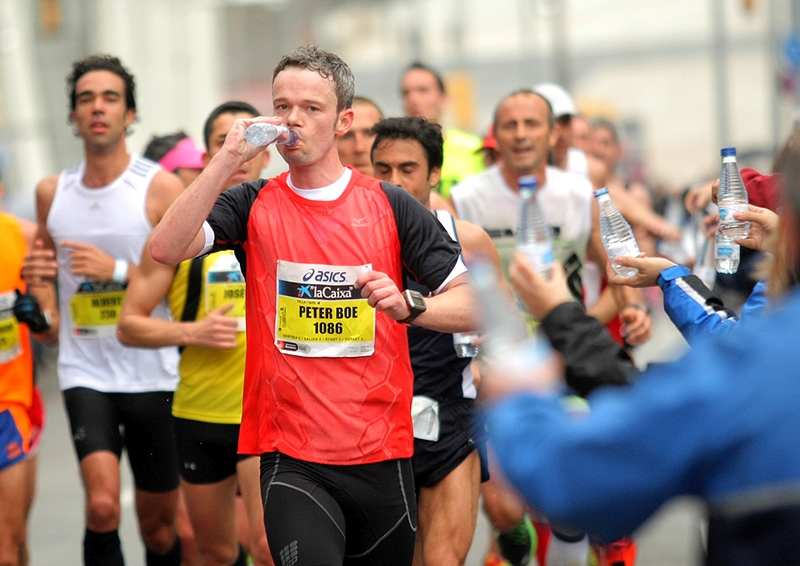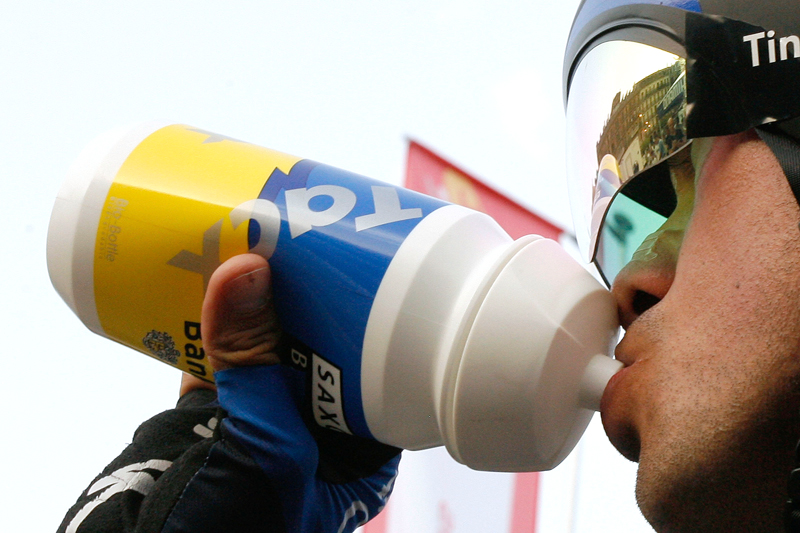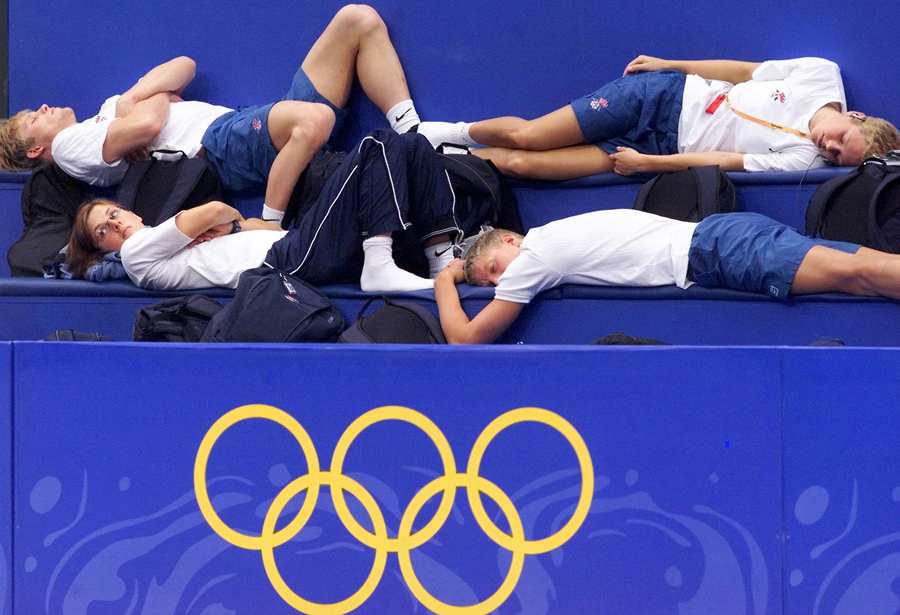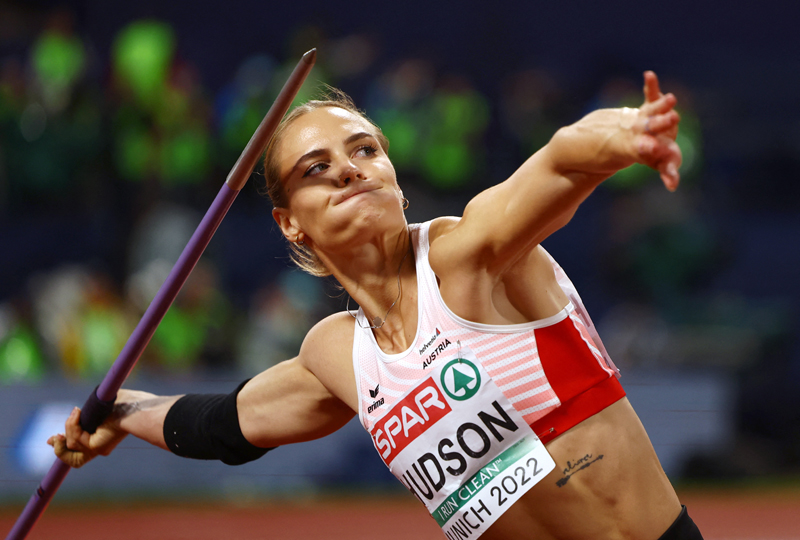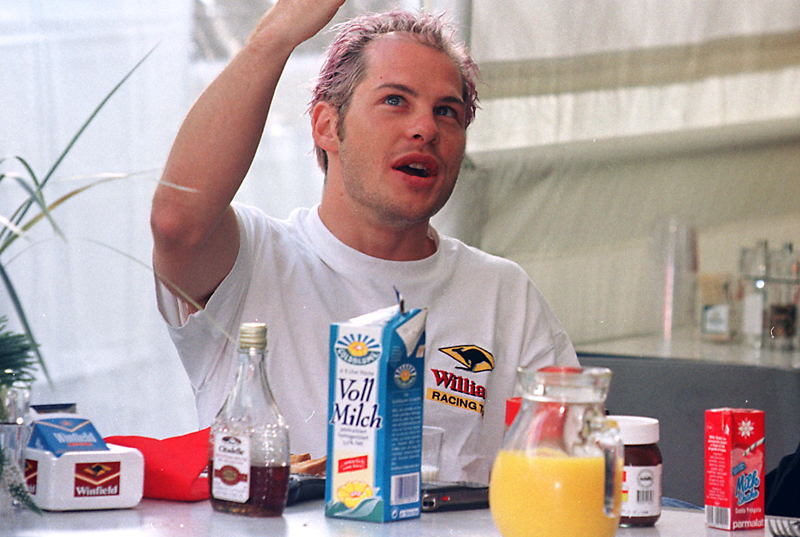You are viewing 1 of your 1 free articles. For unlimited access take a risk-free trial
Sports nutrition and carbohydrate drinks: just how important are they?
Recent research into carbohydrate absorption and utilization has heralded a new breed of carbohydrate drink, which promises genuinely enhanced endurance performance. Andrew Hamilton explains
Before we go on to discuss carbohydrate formulations, it’s worth recapping just why carbohydrate nutrition is so vital for athletes. Although the human body can use fat and carbohydrate as the principle fuels to provide energy, it’s carbohydrate that is the preferred or ‘premium grade’ fuel for sporting activity.There are two main reasons for this. Firstly, carbohydrate is more oxygen-efficient than fat; each molecule of oxygen yields six molecules of ATP (adenosine triphosphate – the energy liberating molecule used in muscle contraction) compared with only 5.7 ATPs per oxygen molecule when fat is oxidised. That’s important because the amount of oxygen available to working muscles isn’t unlimited – it’s determined by your maximum oxygen uptake (VO2max).
Secondly and more importantly, unlike fat (and protein), carbohydrate can be broken down very rapidly without oxygen to provide large amounts of extra ATP via a process known as glycolysis during intense (anaerobic) exercise. And since all but ultra-endurance athletes tend to work at or near their anaerobic threshold, this additional energy route provided by carbohydrate is vital for maximal performance. This explains why, when your muscle carbohydrate supplies (glycogen) run low, you sometimes feel as though you’ve hit a ‘wall’ and have to drop your pace significantly from that sustained when glycogen stores were higher.
Carbohydrate storage
Endurance training coupled with the right carbohydrate loading strategy can maximise glycogen concentrations, which can extend the duration of exercise by up to 20% before fatigue sets in(1). Studies have shown that the onset of fatigue coincides closely with the depletion of glycogen in exercising muscles (2,3).However, valuable as these glycogen stores are, and even though some extra carbohydrate (in the form of circulating blood glucose) can be made available to working muscles courtesy of glycogen stored in the liver, they are often insufficient to supply the energy needs during longer events.
For example, a trained marathon runner can oxidise carbohydrate at around 200-250g per hour at racing pace; even if he or she begins the race with fully loaded stores, muscle glycogen stores would become depleted long before the end of the race. Premature depletion can be an even bigger problem in longer events such as triathlon or endurance cycling and can even be a problem for athletes whose events last 90 minutes or less and who have not been able to fully load glycogen stores beforehand.
Given that stores of precious muscle glycogen are limited, can ingesting carbohydrate drinks during exercise help offset the effects of glycogen depletion by providing working muscles with another source of glucose? Back in the early 1980s, the prevailing consensus was that it made little positive contribution. This was because of the concern that carbohydrate drinks could impair fluid uptake, which might increase the risk of dehydration. It was also mistakenly believed that ingested carbohydrate in such drinks actually contributed little to energy production in the working muscles (4).
Later that decade, however, it became clear that carbohydrate ingested during exercise can indeed be oxidised at a rate of roughly 1g per minute(5-7) (supplying approximately 250kcals per hour) and a number of studies subsequently showed that this could be supplied and absorbed well by drinking 600-1,200mls of a solution of 4-8% (40-80g per litre of water) carbohydrate solution per hour(8-11). More importantly, it was also demonstrated both that this ingested carbohydrate becomes the predominant source of carbohydrate energy late in a bout of prolonged exercise(10), and that it can delay the onset of fatigue during prolonged cycling and running as well as improving the power output that can be maintained(12,13).
Drink formulation
The research findings above have helped to shape the formulation of most of today’s popular carbohydrate drinks. Most of these supply energy in the form of glucose or glucose polymers (see box right for explanation) at a concentration of around 6%, to be consumed at the rate of around 1,000mls per hour, so that around 60g per hour of carbohydrate is ingested. Higher concentrations or volumes than this are not recommended because not only does gastric distress become a problem, but also the extra carbohydrate ingested is simply not absorbed or utilised.But as we’ve already mentioned, 60g per hour actually amounts to around 250kcals per hour, which provides only a modest replenishment of energy compared to that being expended during training or competition. Elite endurance athletes can burn over 1,200kcals per hour, of which perhaps 1,000kcals or more will be derived from carbohydrate, leaving a shortfall of at least 750kcals per hour. It’s hardly surprising, therefore, that one of the goals of sports nutrition has been to see whether it’s possible to increase the rate of carbohydrate replenishment. And now a series of studies carried out by scientists at the University of Birmingham in the UK indicates that this may indeed be possible.
Carbohydrate type and performance
Many of the early studies on carbohydrate feeding during exercise used solutions of glucose, which produced demonstrable improvements in performance as discussed. In the mid-1990s, some researchers experimented by varying the type of carbohydrate used in drinks, for example by using glucose polymers or sucrose (table sugar). However, it seemed that there was little evidence that these other types of carbohydrate offered any advantage(3).
But, at about the same time, a Canadian research team were experimenting with giving mixtures of two different sugars (glucose and fructose) to cyclists. In one experiment cyclists pedalled for two hours at 60% of VO2max while ingesting 500mls of one of five different drink mixtures(14) :
- 50g glucose;
- 100g glucose;
- 50g fructose;
- 100g fructose;
- 100g of 50g glucose + 50g fructose.
Although these findings provided experimental support for using mixtures of carbohydrates in the energy supplements for endurance athletes, it wasn’t until 2003 that researchers from the University of Birmingham in the UK began looking more closely at the issue. In particular, they wanted to see whether combinations of different sugars could be absorbed and utilised more rapidly than the 1.0g per minute peak values that had been recorded with pure glucose drinks.
One of their early experiments compared the oxidation rates of ingested carbohydrate in nine cyclists during three-hour cycling sessions at 60% of VO2max(15). During the rides, the cyclists drank 1,950mls of radio-labelled carbohydrate solution, which supplied one of the following:
- 1.8g per min of pure glucose;
- 1.2g of glucose + 0.6g per minute of sucrose;
- 1.2g of glucose + 0.6g per minute of maltose;
- Water (control condition).
Fructose connection
The same team had also performed another carbohydrate ingestion study on eight cyclists pedalling at 63% of VO2max for two hours(16). In this study the cyclists performed four exercise trials in random order while drinking a radio-labelled solution supplying of one of the following:- 1.2g per min of glucose (medium glucose);
- 1.8g per min of glucose (high glucose);
- 1.2g of glucose + 0.6g of fructose per minute (glucose/fructose blend);
- Water (control).
These findings point strongly to the fact that the maximum rate of glucose absorption into the body is around 1.2g per minute because feeding more produces no more glucose oxidation – probably because the absorption mechanism is already saturated. But because giving extra fructose does increase overall carbohydrate oxidation rates, they also indicate that fructose in the glucose/fructose drink was absorbed from the intestine via a different mechanism than glucose (see box above).
The studies above and others(17) had shown that glucose/fructose mixtures do result in higher oxidation rates of ingested carbohydrate, especially in the later stages of exercise. But what the team wanted to find out was whether this extra carbohydrate uptake could help with water uptake from the intestine, and also whether the increased oxidation of ingested carbohydrate had a sparing effect on muscle glycogen, or other sources of stored carbohydrate (eg in the liver).
To do this, they set up another study using a similar protocol to that above (eight trained cyclists pedalling at around 60% VO2max on three separate occasions, ingesting one of three drinks on each occasion(18)). However, in this study, the duration of the trial was extended to five hours during which the subjects drank one of the following:
- 1.5g per minute of glucose;
- 1.5g per minute of glucose/fructose mix (1.0g glucose/0.5g fructose);
- Water (control).
There were a number of important findings from this study:
- During the last hour of exercise, the oxidation rate of ingested carbohydrate was 36% higher with glucose/fructose than with pure glucose;
- During the same time period, the oxidation rate of endogenous (ie stored) carbohydrate was significantly less with glucose/fructose than with pure glucose;
- The rate of water uptake from the gut into the bloodstream was significantly higher with glucose/fructose than with pure glucose;
- The perception of stomach fullness was reduced with the glucose/fructose drink compared to pure glucose;
- Perceived rates of exertion in the later stages of the trial were lower with glucose/fructose than with pure glucose.
Implications for athletes
These research findings are very encouraging; higher rates of energy production from ingested carbohydrate, lower rates from stored carbohydrate and increased water uptake sounds like a dream combination for endurance athletes. But can a glucose/fructose drink actually enhance endurance performance in real athletes under real race conditions?That’s the question scientists at the University of Hertfordshire are currently trying to answer in a double-blind, placebo controlled study to test commercially available drinks, which was set up earlier this year. The main goal is to compare the effects on cycling performance of a popular glucose/glucose polymer (containing very low levels of fructose – ~3-4%) drink with a 2:1 glucose/fructose drink (trade name of ‘Super Carbs’ – 33% fructose) on cycling performance. The results of these trials are yet to be published, but according to the research team, the initial findings are ‘very promising’.
Recommendations for athletes
If you’re an endurance athlete, is it worth rushing out and trying to get hold of a glucose/fructose drink to use during training/competition? Despite the promising initial research, the cautious approach would be to hold back until scientists have confirmed beyond doubt that these drinks really do confer a performance advantage.However, fructose is cheap, which means these drinks are no more expensive than conventional glucose/glucose polymer drinks; as all the indications are that any performance differences produced by a glucose/fructose drink will be positive, there’s certainly no harm in a ‘try it and see approach’, and possibly much to gain.
Having said that, it’s important to remember that conventional glucose/glucose polymer drinks can still confer proven advantages for endurance athletes when taken during training or competition; both glucose/glucose polymer and glucose/fructose drinks can boost endurance performance over using nothing at all! But should the initial findings above be confirmed, the future for glucose/fructose carbohydrate drinks looks bright.
References
1. Sports Med 1997; 24:73-81
2. Acta Physiol Scand 1967; 71:129-139
3. Williams C, Harries M, Standish WD, Micheli LL (eds) (1998) Oxford Textbook of Sports Medicine, 2nd edn. New York: Oxford University Press
4. Int J Sports Med 1980; 1:2-14
5. Sports Med 1992; 14: 27-42
6. Metabolism 1996; 45:915-921
7. Am J Physiol Endocrinol Metab 1999; 276: E672-E683
8. Med Sci Sports Ex 1993; 25:42-51
9. Int J Sports Med 1994; 15:122-125
10. Med Sci Sports Ex 1996; 28: i-vii
11. J Athletic Training 2000; 35:212-214
12. Int J Sports Nutr 1997; 7:26-38
13. Nutrition Reviews 1996; 54:S136-S139
14. J Appl Physiol 1994; ss76(3):1014-9
15. J Appl Physiol 2004; 96:1285-1291
16. J Appl Physiol 2004; 96:1277-1284
17. Med Sci Sports Exerc 2004; 36(9):1551-1558
18. J Appl Physiol 2006; 100:807-816
Newsletter Sign Up
Testimonials
Dr. Alexandra Fandetti-Robin, Back & Body Chiropractic
Elspeth Cowell MSCh DpodM SRCh HCPC reg
William Hunter, Nuffield Health
Newsletter Sign Up
Coaches Testimonials
Dr. Alexandra Fandetti-Robin, Back & Body Chiropractic
Elspeth Cowell MSCh DpodM SRCh HCPC reg
William Hunter, Nuffield Health
Keep up with latest sports science research and apply it to maximize performance
Today you have the chance to join a group of athletes, and sports coaches/trainers who all have something special in common...
They use the latest research to improve performance for themselves and their clients - both athletes and sports teams - with help from global specialists in the fields of sports science, sports medicine and sports psychology.
They do this by reading Sports Performance Bulletin, an easy-to-digest but serious-minded journal dedicated to high performance sports. SPB offers a wealth of information and insight into the latest research, in an easily-accessible and understood format, along with a wealth of practical recommendations.
*includes 3 coaching manuals
Get Inspired
All the latest techniques and approaches
Sports Performance Bulletin helps dedicated endurance athletes improve their performance. Sense-checking the latest sports science research, and sourcing evidence and case studies to support findings, Sports Performance Bulletin turns proven insights into easily digestible practical advice. Supporting athletes, coaches and professionals who wish to ensure their guidance and programmes are kept right up to date and based on credible science.
